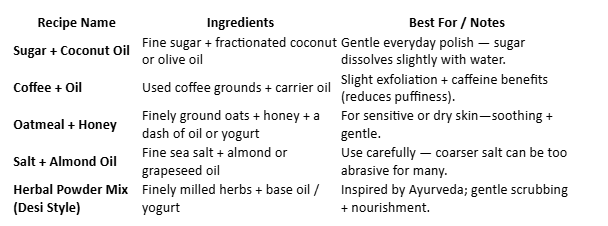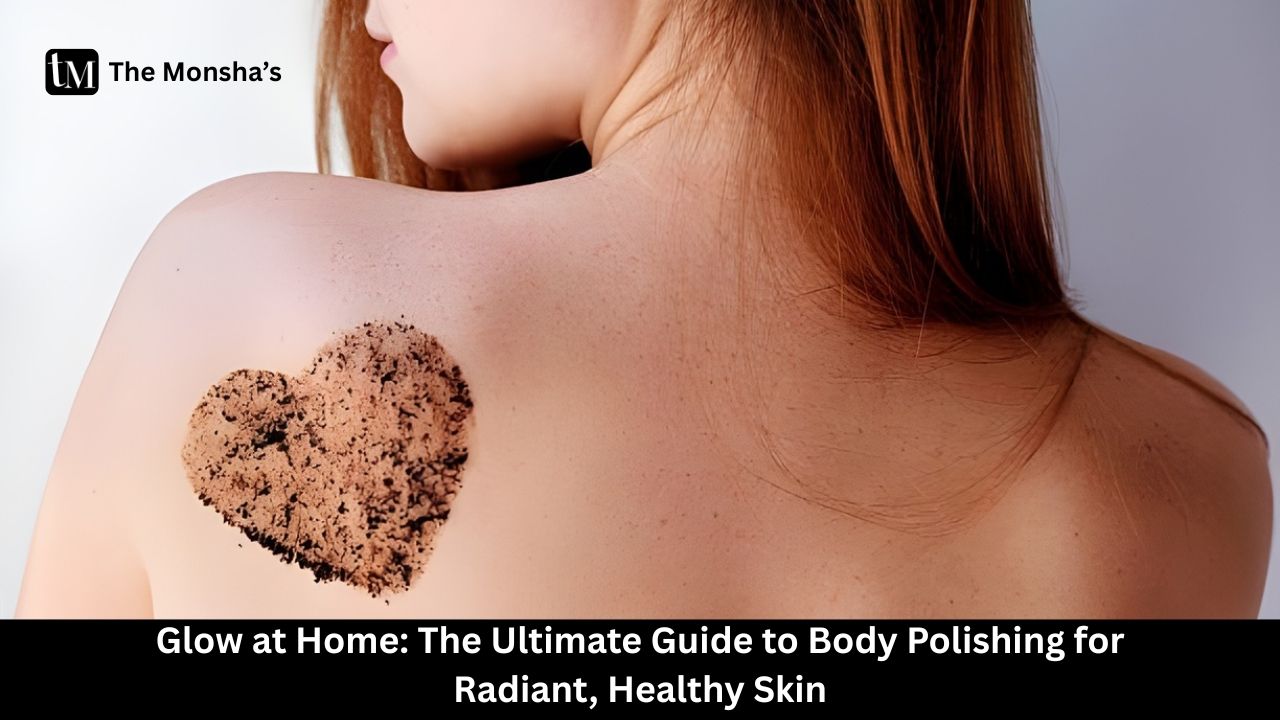TL;DR
Body polishing at home = your secret ticket to smooth, glowing skin from head to toe. With the right scrub, technique, and aftercare, you can buff away dead cells, boost circulation, and let your lotions work harder. But do it wrong — and you may irritate, overdo, or injure your skin. Here’s your full playbook.
1. Let’s Roll
I’ve had days when my face looked decent but my arms, legs, knees cried patches of dryness. That’s when I discovered body polishing — like giving your entire body a facial, but at home, in your own bathroom (robes optional).
In this post, we’ll go step by step: what body polishing is, why it matters, how to do it (without bathing your skin in regret), remedies, risks, and some desi magic to keep your glow game strong. Let’s buff away the dullness together.
2. What Is Body Polishing (And How Is It Different from a Scrub?)
Definition & conceptBody polishing is a more refined form of exfoliation: you remove dead skin layers + nourish, rather than just scrub and rinse. It often combines fine physical exfoliants (sugar, salt, ground oats) suspended in a moisturizing base (oil, cream) so the process is gentler and hydration is built in.
What sets it apart from regular scrubs
- The granules are usually finer / more uniform
- The base (oil / moisturizing agent) cushions and protects
- The goal includes not just exfoliation but also skin nourishment, smoother texture, and prepping skin for better absorption of subsequent products
Dermatologists often caution that aggressive scrubs can damage barrier, so polishing (gentler, moisturizing) is safer for frequent use.
3. Science Behind It: Why Polishing Works
When you polish your body:
- Dead skin removal: it sloughs off dead cells, making skin look smoother and brighter.
- Improved absorption: once the top dead layer is removed, creams and oils penetrate better.
- Enhanced circulation & lymphatic flow: the massage motion stimulates blood flow, helping bring nutrients and oxygen to skin.
- Texture & evenness: consistent polishing helps reduce rough patches, uneven skin tone, and possibly mild hyperpigmentation in body areas.
- Barrier maintenance: because it’s gentler, done right it doesn’t strip oils or damage skin barrier — which harsh exfoliation may do.
In Ayurvedic / Indian body polishing kits, fine “churna” (powder) of herbs + gentle agents is used so you get scrubbing without injury, and hydrating agents like cocoa butter help repair barrier.
4. Home Body Polishing: Step-by-Step Guide
Here’s how you can polish your whole body at home, safely:
4.1 Prep & Safety Check
- Do a patch test on a small less visible area (inner thigh, back of calf).
- Avoid polishing over cuts, rashes, irritated or sunburnt skin.
- Choose time when your skin isn’t too tired or stressed.
4.2 Warm Cleanse / Steam
- Use a warm shower (not super hot) to open pores.
- Use a mild body wash to clear surface dirt.
- Pat skin lightly (don’t fully dry) so some moisture remains — helps spread scrub.
4.3 Apply Oil / Base (Optional, but Recommended)
- Use a light oil (almond, jojoba, coconut, grapeseed) or mix it into your scrub.
- Warm it slightly (in hands) to spread easily.
4.4 Massage in the Polish
- Use the polish (DIY or store) and gently massage in circular motions — small area by area.
- Spend more time on rough zones: knees, ankles, elbows.
- Don’t press hard — let the grains do the work.
4.5 Rinse Off Gently
- Use lukewarm water, no harsh scrubbing while rinsing.
- Avoid hot water which can sting or aggravate.
4.6 Moisturize / Seal
- Right after towel-drying (pat, don’t rub), apply a rich moisturizer or body oil.
- Seal in moisture while skin is damp.
- You can layer with a thicker cream.
4.7 Post-Care
- Avoid sun, friction (tight clothes), or harsh actives for 24 hours.
- Use SPF if you’ll be exposed to sun.
5. DIY Body Polishing Recipes & Options
Here are some safe, effective home recipes for body polishing:

Notes / cautions:
- Avoid sharp, jagged granules (crushed nutshells, coarse apricot seeds) — they may cause microtears.
- Don’t use fresh lemon juice or high concentration citrus — may sting or irritate.
- Always adapt consistency: not too dry, not too runny.
6. Benefits & What You’ll Notice (Short Term & With Consistency)
When you do it right, here’s what your skin can feel / show:
- Immediate: soft, smooth skin, fresh glow, reduced dullness
- Within days: better absorption of your body lotions / oils, more even texture
- Longer term: fewer rough patches, fewer flaky zones, improved radiance
- Helps reduce mild tan / pigmentation in body zones (especially if you include light actives)
Quick benefits list:
- Removes dead layers
- Boosts circulation & lymph flow
- Unlocks product absorption
- Helps maintain an even tone
- Makes skin feel more supple
7. Risks, Mistakes & What Can Go Wrong 😬
Even the best intentions can backfire if you're careless. Watch for:
- Over-scrubbing → barrier damage, redness, sensitivity
- Too frequent polishing → dryness or irritation
- Using harsh or jagged granules → microtears
- Skipping patch test → allergic reaction
- Polishing over inflamed / broken skin → makes things worse
- Delaying moisturizer → leaving skin exposed and tight
- Sun + friction too soon → stinging, dark spots
Dermatologists often caution that exfoliation (mechanical or chemical) must be gentle — misuse can disrupt barrier, cause irritation or even pigmentation, especially for darker skin tones.
If you ever feel burning, prolonged stinging, or see peeling — stop immediately.
8. Best Practices & Safety Tips
- Frequency: once every 7–14 days, or even just once a month if skin is sensitive
- Always do patch test (24 hours before)
- Use fine / micro yes — coarse or jagged no
- Use gentle pressure, not aggressive rubbing
- Don’t polish right after waxing, retinoids, or chemical peels
- Moisturize immediately
- Apply sunscreen (polished skin is more susceptible)
- Avoid heat, sauna, tight clothes for next 24 hrs
9. DIY vs Salon Body Polishing: What’s Better?

Often the best balance: get a salon polish occasionally (for deep session) and maintain at home.
10. Real Stories & Tips from the Trenches
I remember one night after a long shoot: my arms looked like crepe paper. I mixed a quick coffee + honey polish, massaged lightly, and after rinsing — wow — skin felt silkier. But I overdid it, skipped moisturizer, and by next morning, legs had scaly patches. Lesson: always seal the moisture and don’t overdo.
Many Indian users report using besan (gram flour) + turmeric + milk in their polish mixes — gentle and skin-loving. Try that on a lazy Sunday.
11. Final Takeaway & Glow Checklist
Body polishing is not just vanity — it’s a skin health booster when done thoughtfully. But more isn’t always better. Follow smart technique, use good DIY recipes or trusted products, and listen to your skin.
Glow checklist:
- Patch test done? ✅
- Gentle polish recipe chosen? ✅
- Warm shower prep done? ✅
- Massage in circles, minimal pressure? ✅
- Rinse, pat, moisturize immediately? ✅
- Skip sun / friction today? ✅
A little polish, a lot of glow.
12. FAQs
Q. Can I body polish every day?
No, too frequent polishing can irritate. Once a week (or once every 10–14 days) is more reasonable.
Q. Is it safe right after waxing / shaving?
Wait at least 48 hours (or until skin fully calmed) before polishing.
Q. Which scrubs are too harsh?
Large jagged granules (nutshell bits, coarse salt) — avoid them, they can scratch skin.
Q. What if I see redness or irritation?
Stop immediately. Apply aloe, soothing agents, and skip polishing until healed.
Q. How soon can I polish again after doing it once?
Wait skin to fully recover, usually 7–14 days (depends on your skin).


